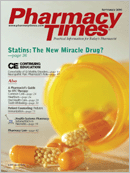Appropriate Usage of Indomethacin in the NICU Department
A pharmacy department plays an important role in every hospital across the country. It provides a synchronized multidisciplinary service to patients - especially to high-risk newborns in the neonatal department. Medications are delivered from the pharmacy to neonate patients with different complicated medical conditions, such as persistent pulmonary hypertension of the newborn, patent ductus arteriosus (DA), congestive heart failure, and intraventricular hemorrhage (IVH). It is necessary to adjust paper or computerized ordering pathways in response to changes made yearly in medications and treatment guidelines for the neonatal patient population. Neonatal pharmacy is one of the most sensitive areas in the pharmaceutical industry. The unique clinical conditions and dosing guidelines specifically for newborn patients separate them from the rest of the patient population. Neonates, depending on their age (specifically by a day of life) and weight, have specific fluid, nutritional, and electrolyte needs. One of the important issues in this field of pharmacy is the appropriate use of indomethacin. Indomethacin is a member of the nonsteroidal antiinflammatory drug (NSAID) group of medications. It is used in the closure of the DA and in the prevention of IVH. Before birth, a baby does not breathe on its own, and its blood receives oxygen from the placenta and blood circulating from the mother. The presence of the DA structure - which connects the pulmonary artery, particularly the left one, to the descending aorta - thus allows the blood flow to avoid traveling through the lungs. The DA is kept open through complicated chemical mechanisms, in addition to the effects of locally released and circulating prostaglandins (PGs), particularly PGE2. After birth, the baby begins to breathe on its own. The DA closes in order for a neonate body to deliver blood to the lungs to be oxygenated and to be circulated throughout the body. Patent ("open") ductus arteriosus (PDA) is a condition in which the DA is still open after the birth of a neonate. Usually PDA is present in low-birthweight prematurely born neonates. PDA can be diagnosed in neonates by some imaging studies, such as echocardiography and magnetic resonance imaging. PDA is a medical condition that creates complications, such as increased pulmonary blood flow, respiratory distress syndrome, and enlargement of the left ventricle and atrium, leading to congestive heart failure. In addition, the presence of PDA is associated with reduced middle cerebral artery blood flow velocity. PDA also is associated with an increased risk of IVH, necrotizing enterocolitis, chronic lung disease, and death. Conditions such as PDA can be treated with indomethacin or with surgery. Neofax 2004 suggests using indomethacin, with doses based on the age and weight of a newborn, to be infused intravenously over at least 30 minutes to minimize side effects. It suggests giving doses at intervals of 12 to 24 hours. Neofax 2004 allows using longer periods of treatment for up to 7 days. The theory behind this treatment is that indomethacin, as a member of the NSAIDs group, will inhibit 2 kinds of cyclooxygenase, COX-1 and COX-2, and block PG synthesis, including PGE2, thus inducing the DA to close and reducing cerebral blood flow velocity. The use of indomethacin is contraindicated in neonates who are allergic to this medical compound, have untreated infection, have active internal bleeding, or have thrombocytopenia, in addition to standard contraindications to the use of NSAIDs.
When medical treatment is contraindicated for a patient, surgery plays an important role in helping patients with PDA. Surgical ligation is a type of surgery that is performed even in the smallest premature babies. Unless contraindicated, video-assisted thoracoscopic surgery (VATS) has potential advantages over the regular open surgical PDA ligation. VATS involves small 3-mm incisions and involves neither cutting the chest wall muscles nor retracting ribs. This surgical procedure decreases the chances of injury to the nerves and rupturing the ligaments.
IVH is another condition associated with very low-birth-weight neonates. This condition can be provoked by alterations in the cerebral blood flow in the anterior cerebral arteries. In addition, some analysis has shown that neonates who were born prematurely, and whose mothers received magnesium sulfate before giving birth, might have an increased risk for IVH. Cranial sonography commonly is used as a screening procedure to diagnose IVH. If not prevented or left untreated, IVH can lead to complications such as periventricular hemorrhagic infarction and hydrocephalus. Based on a number of studies showing that early prevention of IVH in very low-birth-weight neonates decreases the occurrence of IVH, medical guidelines advise preventing IVH with specific doses of indomethacin. Neofax 2004 suggests starting prevention at 6 to 12 hours of age, administering an indomethacin dose of 0.1 mg/kg q 24 hours for 3 doses. Again, indomethacin was chosen for this usage because of its ability to block cyclooxygenase and to decrease PG production, thus decreasing the alterations in cerebral blood flow.
It is very important for a pharmacist to recognize the 2 different indications for the use of indomethacin. These different diagnoses are intended to be medicated with different doses and for a different duration of time. Thus, a pharmacist working in a neonatal environment (such as a neonatal intensive care unit) should pay extra attention to the diagnosis and should provide a physician with the necessary information regarding treatment and a specific medication period. In addition, hospitals providing health care to the neonatal population should develop an ordering system on paper or in the computer, allowing physicians to order indomethacin for a specific diagnosis and for a necessary duration only, if the department utilizes indomethacin for more than one indication.
Dr. Motylev is a pharmacy manager in the hospital setting.

